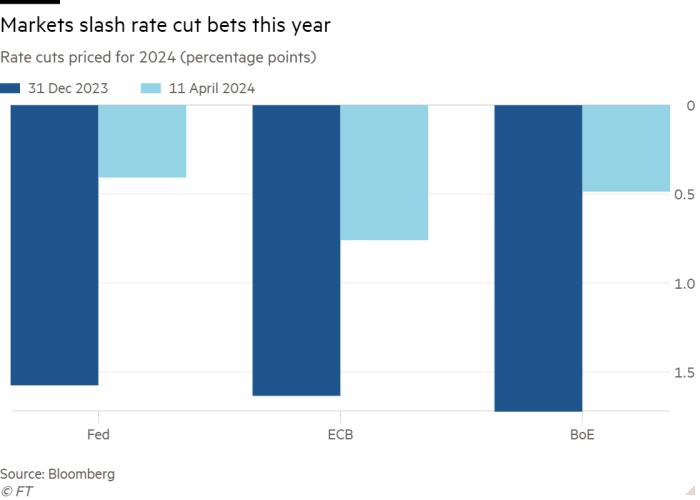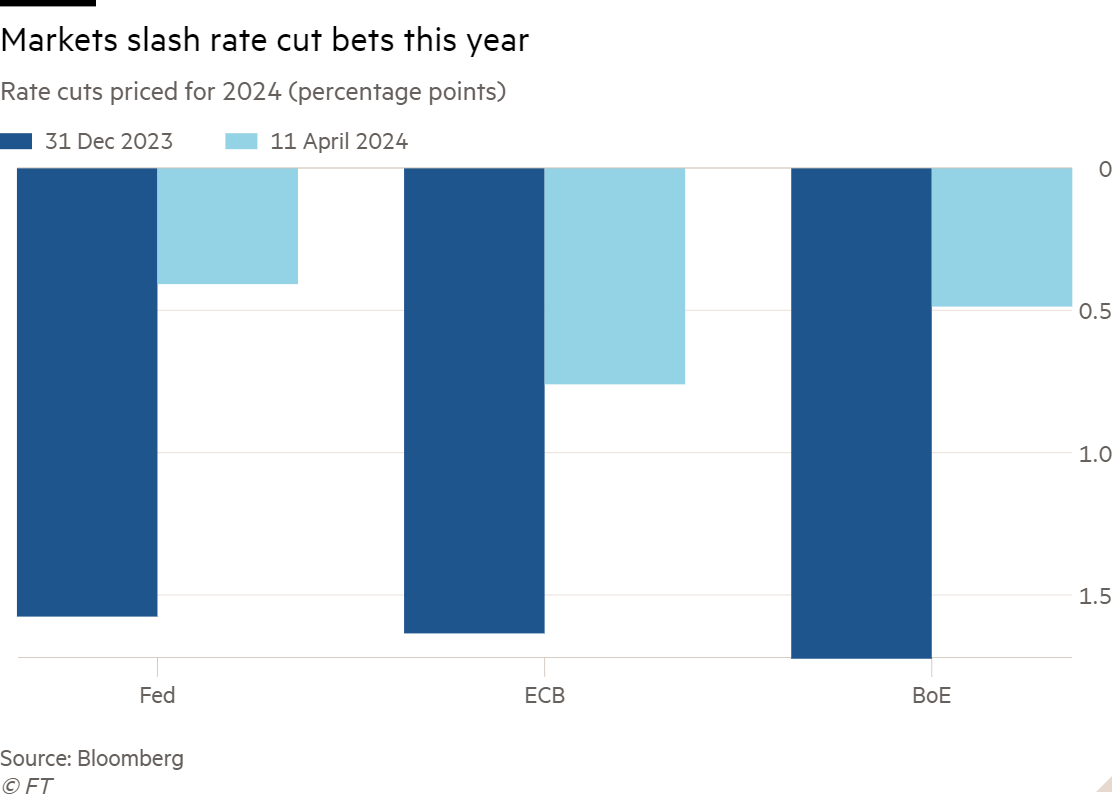Unlock the Editor’s Digest for free
Roula Khalaf, Editor of the FT, selects her favourite stories in this weekly newsletter.
The European Central Bank sent a strong signal that it would consider cutting interest rates at its next meeting in June after holding them at all-time highs on Thursday.
The ECB said after its governing council met in Frankfurt that its benchmark deposit rate would stay at 4 per cent until rate-setters were sure price pressures had stabilised.
But its president Christine Lagarde told reporters that a small minority of policymakers had argued for an immediate cut.
In a shift from previous language, the ECB said it “would be appropriate” to cut rates if underlying price pressures, its updated forecasts and the impact of previous rate rises increased its confidence that inflation was closing in on its 2 per cent target “in a sustained manner”.
Eurozone inflation has fallen from a 2022 peak of 10.6 per cent to 2.4 per cent in March — tantalisingly close to the central bank’s goal.
“What the ECB has done today comes very close to a pre-commitment to cut rates in June,” said Jörg Krämer, chief economist at Commerzbank in Frankfurt. “It will take a lot of very bad inflation and wage data for them not to do that now.”
Lagarde said “bumps in the road” could cause inflation to “fluctuate” over the coming months before falling to its target by mid-2025. She said “recent indicators point to further moderation in wage growth” while the overall risks to growth “remain tilted to the downside.”
Asked if Thursday’s decision to keep rates on hold was unanimous, she said “a few members felt sufficiently confident” to argue for a cut. But she added the minority “agreed to rally to the consensus of the very, very large majority of members” who wanted to wait at least until June.
Markets initially shrugged off the central bank’s statement. But the euro later slipped 0.3 per cent against the dollar to $1.0706 while the rate-sensitive 2-year German Bund yield — a benchmark for the eurozone — rose 0.02 percentage points to 2.8 per cent.
Traders in swaps markets slightly downgraded the likelihood that the ECB will begin cutting rates in June to around 70 per cent, from 75 per cent earlier in the day.
Markets’ rate-cut expectations have been shaken by data this week showing US inflation rose more than expected in March.

Investors have responded by slashing their bets on Federal Reserve rate cuts, to which they now ascribe only a 50 per cent likelihood before September. Traders have also scaled back their expectations of how many rate cuts the ECB and Bank of England will make this year.
Some eurozone policymakers, as in the UK, may want to avoid cutting rates much more aggressively than their counterparts in the US, partly out of fear of weakening their currencies and so further stoking inflation.
But Lagarde pushed back against the idea that the ECB was not prepared to cut rates unless the Fed did so too.
“We are data-dependent, not Fed-dependent,” she said, adding that inflation in the US and eurozone were “not the same” and warning against drawing conclusions from one for the other.
Ann-Katrin Petersen, a strategist at the BlackRock Investment Institute, emphasised that, compared with the Fed, “the ECB faces weaker growth and has hiked policy further into restrictive policy”.
She added: “So the ECB will probably cut first, but may then move more slowly if the Fed delays cuts.”
ECB shifts tone from March
April 2024
“ . . . the key ECB interest rates are at levels that are making a substantial contribution to the ongoing disinflation process . . . If the Governing Council’s updated assessment of the inflation outlook, the dynamics of underlying inflation and the strength of monetary policy transmission were to further increase its confidence that inflation is converging to the target in a sustained manner, it would be appropriate to reduce the current level of monetary policy restriction.”
March 2024
“ . . . the key ECB interest rates are at levels that, maintained for a sufficiently long duration, will make a substantial contribution to this [2 per cent inflation] goal . . . The Governing Council will continue to follow a data-dependent approach to determining the appropriate level and duration of restriction.”
Read More: World News | Entertainment News | Celeb News
FT









